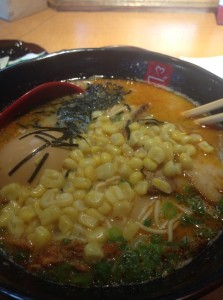 Starting with 50,000 dollars, Ryu Isobe has operated his ramen restaurant for one year and eight months. He and his partner are planning to open another one in Hollywood area this year.
Starting with 50,000 dollars, Ryu Isobe has operated his ramen restaurant for one year and eight months. He and his partner are planning to open another one in Hollywood area this year.
“This time we will spend 700,000 dollars to build a fine place for my ramen restaurant,” Isobe drank a sip of coke and continued. “I lived in United States for 11 years. I always want to open business or doing something related to Japan. I’m a Japanese. You know, there are so many ramen restaurants in Japan but here there is not that much,” said Isobe.
According to a report from National Restaurant Association, driven by a stronger economy and historically high levels of pent-up demand among consumers, restaurant-industry sales are expected to hit a record high of $683.4 billion in 2014. There are 17 ramen restaurants in Los Angeles.
When you enter the ramen restaurant, you will find three iPads for self-ordering and self-payment. You just need to hold your receipt and wait to be seated. The high-tech mechanism attracts a lot of young people.
“We only have 29 seats but we could serve 700 people one day during weekends…every customer spends around 15-20 minutes…most of them are college students…sometimes you can see some 30+ customers and even high school students,” said Isobe.
Born in 1988, Isobe graduated from USC business school in 2011. However, he didn’t choose to jump into the ramen business right after graduation.
“I spent almost one year to find a great location…I think that’s one of the most important elements for my business…and also I want to make my ramen taste unique,” said Isobe.
Isobe learned to cook ramen all by himself. He said that he wants to make ultra-specialized Hakata-style tonkotsu, whose preparation is more rigidly structured than most medical practices, a Tokyo-style fusion.
“You can find ramen restaurants in Japan every where and they all taste much better than here…especially the tonkotsu,” said Isobe.
According to abc News from Jan 2012, economists were forecasting even more sticker shock in 2012. The price of just about everything — fueled up bond. From gasoline — caffeine to breakfast is filling up. However, it didn’t stop Isobe opening his first restaurant in May 2012.
As we know, during the recession, consumers spent less on luxuries such as dining out. However, when they did visit restaurants, they purchased lower-priced items. Moreover, consumers have become increasingly health conscious over the past five years, according to PR Web.
“I actually wasn’t impacted by the price or recession. People always need to eat and my ramen only costs around 10 dollars per bowl…we put all ingredients in ramen…it is not expensive,” said Isobe.
Isobe’s ramen restaurant is not the first one on Sawtelle Blvd, but it must be one of the hottest restaurants. He gets lots of emails for franchising every week, but he never replies.
“My goal is to open my ramen fast food chain restaurants all around US as Panda Express. I think we need real fast ramen food,” said Isobe.
As a new comer, Isobe didn’t spend any money on marketing his ramen restaurant. On the opposite, he put more attention on training waiters and designing ordering system.
“All my employees are Americans…they don’t speak Japanese…I spent a lot of time on training them to be a great waiter…I created simple rules for them to follow such as when to add water for customers…I taught them step by step,” said Isobe.
According to a report on restaurants from IBIS world, the single location full-service restaurants industry has bounced back after a slowdown due to reduced consumer spending during the recession. In 2009, revenue declined 0.9%. Over the five years to 2013, IBISWorld estimates industry revenue will grow at an average annual rate of 2.3% to $137.5 billion. Revenue is expected to continue its upward trajectory in 2013, growing an estimated 3.1%.
Isobe never makes a loan from banks nor accept any angel investments. He has a partner to work out all money issues together. Even though Isobe’s ramen restaurant wasn’t impacted by recession economy, he’s still facing challenges. The biggest one is labor.
Another report from U.S. Bureau of Labor shows that California is one of the nine states with highest unemployment rate, which reaches 8.5%. Last year, Gov. Jerry Brown endorsed a bill that would raise California’s minimum wage to $10 an hour by January 2016. Employers countered that a substantial jump in the minimum wage could be disastrous for small businesses, particularly the state’s 87,000 restaurants, according to LA Times. It makes even harder for Isobe to find appropriate employees.
The gains remain below what would be expected during a normal post-recession period due to a range of challenges. However, the restaurant industry will remain the nation’s second-largest private sector employer with a workforce of 13.5 million, according to National Restaurant Association.
“The biggest challenges I’m facing is labor…I hired 40 people in total…it’s really hard to find perfect employees now,” said Isobe.
Leave a Reply
You must be logged in to post a comment.